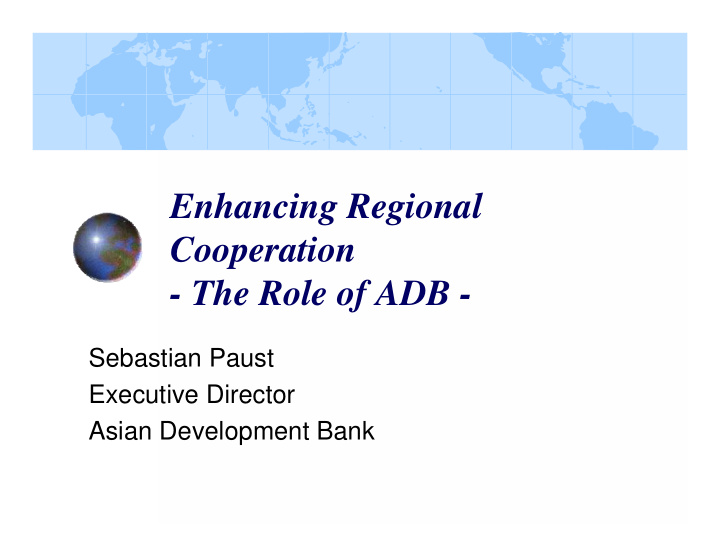



Enhancing Regional Cooperation - The Role of ADB - Sebastian Paust Executive Director Asian Development Bank
Positive Impacts of Financial and Monetary Cooperation/Integration Regionally integrated financial and monetary markets can lead to deeper and more liquid regional financial markets more efficient and competitive financial services promoting trade in goods and services enlarge opportunities for raising capital enlarge opportunities for investments Consequence : creating economies of scale and promoting financial but also economic and political stability in the region
The European Example EU’s financial and monetary cooperation as an important pillar for EU integration and financial stability in the European region EU monetary union and the adoption of a single currency have reduced transaction costs and increased trade by removing exchange rate risks and cost of currency hedging, reducing information costs and enhancing price transparency. led to deeper and more unified European financial markets, e.g. by enlarging the corporate bond market and the equity market.
The European Example made Europe-wide strategies of firms and investors easier and further increased trade and financial flows (significant increase in cross-border M&A deals in EU). acted as a powerful catalyst for further structural change in the EU, especially in the financial sector (coordinated EU regulatory and supervisory framework with the later aim of a European Financial Services Authority EFSA as single EU regulatory and supervisory authority). set the ground for far-reaching policy coordination (ECB; strict rules to public finances and especially deficits, combined with sanctioning mechanisms).
Current Situation in Asia Low level of regional financial and monetary integration (compared to EU) Most far reaching approaches: ASEAN (plus 3): Chiang Mai Initiative (Pool?), Common Bond Market Initiative etc. EMEAP (Executives’ Meeting of East Asia and Pacific) and its Asian Bond Funds No visible role played by SAARC
Current Situation in Asia Obstacles: Asian investors tend to invest outside the region National financial systems generally still underdeveloped and weak (although much more solid and advanced since crisis 97/98) Patchiness of market opening and capital market liberalization across Asia Lack of will to integrate/cooperate
ADB - a Catalyst for Regional Integration ADB-President Kuroda: “When I speak on the subject of Asian integration, some may call me a dreamer” ADB as the only true pan-Asian regional institution ADB’s Strategy 2020 with ADB’s Regional Cooperation and I ntegration Strategy 1. Cross-Border I nfrastructure (Physical connectivity) 2. Trade and I nvestment (FTAs, intra-regional investments, WTO issues)
ADB - a Catalyst for Regional Integration 3. Monetary and Financial Cooperation and I ntegration 4. Provision of Regional Public Goods (Environment, communicable diseases, money laundering etc.) ADB’s non-lending support for monetary and financial cooperation and integration: Research, analysis and knowledge source capacity building and institutional strengthening support for policy dialogue (ASEAN, SAARC, CAREC, APEC, ASEM etc.)
ADB - a Catalyst for Regional Integration Not to forget: ADB’s lending and non-lending support for the domestic financial sector in its Asian member countries (US$ 1.1 billion in 2007, US$ 17 billion cumulative as of 2007) “Emerging Asian Regionalism” and its 5 key messages: 1. Asian integration is an idea whose time has come, and the case for greater regional integration in Asia is broad, deep, and compelling.
ADB - a Catalyst for Regional Integration 2. Asian integration has generally been market-led and private-sector driven: going forward, this market-led process would benefit from a helping hand from increased intergovernmental cooperation especially in economic and financial terms. 3. While Asia can learn some useful lessons from Europe, its model is unique and with distinct characteristics. Asia has to calibrate its own model of integration to suit its huge diversity – in terms of economic, social, political, cultural and historical conditions.
ADB - a Catalyst for Regional Integration Asia is following an outward-looking model of 4. integration – what many experts call “open regionalism”. Building on this, the long-term objective should be to achieve an internally integrated, yet globally connected Asia. Asian integration is good for the countries 5. involved, the region as a whole, and the world at large (= lesson learnt by current financial crisis!).
6 Regional Lessons from the Current Crisis 1. Continue to strengthen national financial systems including prudential standards for governance and transparency 2. Improve surveillance of financial markets (final target: “Asian Financial Stability Dialogue”) 3. Harmonize standards and mutual recognition 4. Liberalize capital accounts and cross-border financial services flows, but prudently (proper sequencing of measures with stable and solid financial conditions) 5. Speed up preparations for regional currency pool to diversify risks and deepen regional policy dialogue 6. Make Asian stock exchanges cooperate closer to set up the ASEAN Board (bulletin board that will provide real-time market data of securities from each exchange)
1 Global Lesson from the Current Crisis The undissolvable monetary and financial triangle: Sound domestic financial systems Sound regional integration and cooperation Sound global governance Consequence : No antagonism, but adequate division of labor and close coordination plus cooperation between domestic and regional entities like ADB on the one side and I MF and other international financial institutions on the other side to create a global safety network a la Bretton Woods I I against future financial crises.
Recommend
More recommend